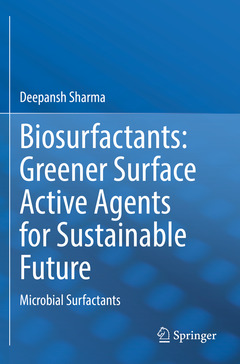Description
Biosurfactants: Greener Surface Active Agents for Sustainable Future, 1st ed. 2021
Microbial Surfactants
Author: Sharma Deepansh
Language: English
Subjects for Biosurfactants: Greener Surface Active Agents for...:
Publication date: 10-2022
194 p. · 15.5x23.5 cm · Paperback
Publication date: 10-2021
Support: Print on demand
Description
/li>Contents
/li>Biography
/li>Comment
/li>
This book illustrates the importance and significance of the biosurfactants obtained from microorganisms, preferably from bacteria and yeast. It explains the superiority of biosurfactants (green molecule) over chemically synthesized surfactants for the sustainable future. The content of the present book addresses the quest for novel biosurfactants producing strains, high throughput screening methods, and production strategies. It finely describes the aptness of biosurfactants for industrial and environmental applications. It elaborately describes the technical background and cutting-edge advancement of the commercial aspect of biosurfactants. In the later part of the book, the role of green biosurfactants in food processing, control of food spoilage, incorporation in personal health care products, environmental and agricultural remediation are discussed. Finally, the book elucidates a comprehensive and representative description of toxicity assessment of the biosurfactants, which highlights the risk assessment of the incorporation of the microbial biosurfactants in food, healthcare, and pharmaceutical formulations.
Dr. Deepansh Sharma, Ph.D., is an Assistant Professor senior grade and Coordinator of the Funds for Improvements of Science and Technology Infrastructure (DST-FIST) at Microbiology Department, Amity University Rajasthan. His primary research interests are in functional foods, probiotics, and novel holistic food formulations. He has completed his Ph.D. in the field of Industrial and Food Microbiology from Karlsruhe Institute of Technology, Germany. Following his doctorate, he pursued his postdoctoral research at the Division of Dairy Microbiology, National Dairy Research Institute, Karnal, India. He has 12 years of research and teaching experience in food and Microbiology. He has produced 35 scientific publications, authored, or edited 7 international books and more than 30 book chapters. Dr. Deepansh Sharma has filed various patents related to microbial metabolites and controlled fermentation processes. He has been selected for the prestigious DAAD fellowship to work in Germany as a visiting researcher, young scientist award, and research excellence award from the Institute of Scholars, India. He was also selected as a Project Investigator by the Department of Science and Technology, the Government of India, and various food industries. Dr. Deepansh Sharma is presently working on the possibilities of biosurfactants as an active ingredient in the food processing industry. He is an active contributing member of the American Society of Microbiology and Association of Microbiologists of India.
Unique comparison of chemical surfactants and biosurfactants
Precisely compilation of incidence and screening of next generation biosurfactants
Data interpretation of patent mapping and future trends
Toxicity assessments for possible future utilization




